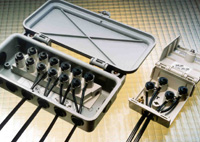 Photo ©1998 AMP INC.
Photo ©1998 AMP INC.There are slight differences in stress relaxation resistance depending on the orientation of the contact beam relative to the parent strip. If the beam length is perpendicular to the direction the metal strip was rolled, the bending stress in the beam is "transverse"; when the length is parallel, the stress is "longitudinal". One way to avoid confusion is to remember that a sample cut for a bad-way bend test has its length oriented transverse to the direction of roll; when bent, it's stressed in the same manner as a transverse stress relaxation test. In both these longitudinal and transverse orientations, the thickness of the beam is the thickness of the strip and the applied force is perpendicular to plane of the strip. Sometimes parts are stamped from strip such that the width of the beam is the thickness of the strip and the applied force lies in the plane of the strip. This has been referred to as "Z-direction"; both longitudinal and transverse Z-directions are used.
Relaxation resistance is not consistently better in one direction than the other, relative to how the part is oriented on the strip. Some alloys tend to be more resistant to stress relaxation in the longitudinal direction, while others perform somewhat better with a transverse orientation. Fortunately, orientation is of secondary importance, relative to alloy, temperature, and time. Differences in the loss of contact forces caused by orientation are rarely as much as ten percent and frequently are less than five percent, even after ten years of applied stress. It is always best, especially when stress relaxation is a critical factor, to obtain details of the particular behavior of the chosen alloy from the strip supplier before deciding upon how to orient the part on the strip.
